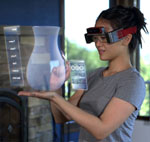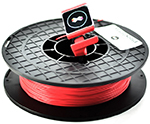 Virtual reality got me interested in technology in the early 1990′s. Two decades ago, “cyberspace” was still an exciting new concept. I’ve met several virtual reality pioneers over the years, including VPL Research co-founder Jaron Lanier, hardware hacker Mitch Altman, and cyberpunk sci-fi author Rudy Rucker. The vision for virtual reality was the ability to put on a pair of stereoscopic glasses and instantly join a realtime tribal jam session with other cybercitizens playing MIDI-powered virtual instruments. The recent acquisition of Oculus by Facebook breathes new life into virtual reality. However, 3d glasses themselves are little more than fancy telephones (Eyephones). SpaceBase, Thalmic Labs MYO Armband, Meta SpaceGlasses, and Casetext are YC companies building solutions with virtual reality applications.
Virtual reality got me interested in technology in the early 1990′s. Two decades ago, “cyberspace” was still an exciting new concept. I’ve met several virtual reality pioneers over the years, including VPL Research co-founder Jaron Lanier, hardware hacker Mitch Altman, and cyberpunk sci-fi author Rudy Rucker. The vision for virtual reality was the ability to put on a pair of stereoscopic glasses and instantly join a realtime tribal jam session with other cybercitizens playing MIDI-powered virtual instruments. The recent acquisition of Oculus by Facebook breathes new life into virtual reality. However, 3d glasses themselves are little more than fancy telephones (Eyephones). SpaceBase, Thalmic Labs MYO Armband, Meta SpaceGlasses, and Casetext are YC companies building solutions with virtual reality applications.
SpaceBase by Parallel Universe
 SpaceBase, by Parallel Universe, is real-time spatial database server software for applications that require very low latencies or very frequent updates. Spatial data, as explained by Parallel Universe, is unique in usually having a high level of concurrency. Virtual worlds require objects to interact and change in real-time through an all-or-nothing atomic model. There’s currently no open-source standard for spatial databases. Most developers of multiplayer worlds either write their own code or license expensive MMO code from another company. Independent developers can’t create such environments because the resources required to get started form a barrier to entry. I wrote in-depth about SpaceBase back in December.
SpaceBase, by Parallel Universe, is real-time spatial database server software for applications that require very low latencies or very frequent updates. Spatial data, as explained by Parallel Universe, is unique in usually having a high level of concurrency. Virtual worlds require objects to interact and change in real-time through an all-or-nothing atomic model. There’s currently no open-source standard for spatial databases. Most developers of multiplayer worlds either write their own code or license expensive MMO code from another company. Independent developers can’t create such environments because the resources required to get started form a barrier to entry. I wrote in-depth about SpaceBase back in December.
Thalmic Labs MYO
 MYO Armband, a product of Thalmic Labs, is a one-size-fits-all armband for gesture control of your computer or smartphone. MYO works by detecting electrical activity generated through arm movement, connects wirelessly to your device using Bluetooth, and supports an API for developers. Wearable devices like MYO Armband provide an input device for actually doing things in cyberspace. Thalmic Labs recently created a demonstration of MYO Armband working with Oculus Rift.
MYO Armband, a product of Thalmic Labs, is a one-size-fits-all armband for gesture control of your computer or smartphone. MYO works by detecting electrical activity generated through arm movement, connects wirelessly to your device using Bluetooth, and supports an API for developers. Wearable devices like MYO Armband provide an input device for actually doing things in cyberspace. Thalmic Labs recently created a demonstration of MYO Armband working with Oculus Rift.
Meta SpaceGlasses
 Meta Spaceglasses are augmented reality glasses with motion detection, effectively Google Glass meets Microsoft Kinect. The Unity 3d SDK platform enables developers to create new apps for Spaceglasses. Meta has already created an App Idea Store, which is a place for developers to share potential app ideas. The real value in Meta Spaceglasses may be the ability to manipulate virtual objects without wearing anything except a pair of glasses. Meta Spaceglasses and MYO Armband were both featured in a September post about wearable devices.
Meta Spaceglasses are augmented reality glasses with motion detection, effectively Google Glass meets Microsoft Kinect. The Unity 3d SDK platform enables developers to create new apps for Spaceglasses. Meta has already created an App Idea Store, which is a place for developers to share potential app ideas. The real value in Meta Spaceglasses may be the ability to manipulate virtual objects without wearing anything except a pair of glasses. Meta Spaceglasses and MYO Armband were both featured in a September post about wearable devices.
Casetext
![]() Casetext is a free legal research tool that lets you annotate the law. With Casetext, you can search using keywords or citations, read the full text of over one million federal and Delaware cases, and learn insights from the annotations of practicing attorneys, professors, and other experts. What does this have to do with virtual reality? Cyber rights. Non-profits like the Electronic Frontiers Foundation already exist to protect user privacy, free expression, and other freedoms in developing technology. Issues like ownership of property created in virtual reality and protection of civil liberties will only get more complicated. Casetext provides legal research for knowing your cyber rights.
Casetext is a free legal research tool that lets you annotate the law. With Casetext, you can search using keywords or citations, read the full text of over one million federal and Delaware cases, and learn insights from the annotations of practicing attorneys, professors, and other experts. What does this have to do with virtual reality? Cyber rights. Non-profits like the Electronic Frontiers Foundation already exist to protect user privacy, free expression, and other freedoms in developing technology. Issues like ownership of property created in virtual reality and protection of civil liberties will only get more complicated. Casetext provides legal research for knowing your cyber rights.
Conclusion
Many markets will benefit from virtual reality use-cases. Education, medical research, live events, fashionable wearable devices, social media, 3D printing, and robotics are just some of the applications of virtual reality technology. It will be interesting to see all the real wealth created through technology advances in cyberspace. Companies like SpaceBase, Thalmic Labs MYO Armband, Meta SpaceGlasses, and Casetext are just the start.
Amazing
 Smartwatch+ Wins Pebble App Challenge
Smartwatch+ Wins Pebble App Challenge
 MadeSolid Is Better Materials For 3D Printers
MadeSolid Is Better Materials For 3D Printers
